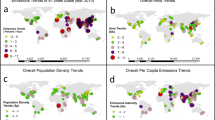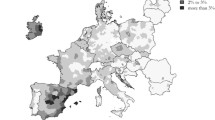Abstract
The purpose of this paper is to describe global urban greenhouse gas emissions by region and sector, examine the distribution of emissions through the urban-to-rural gradient, and identify covariates of emission levels for our baseline year, 2000. We use multiple existing spatial databases to identify urban extent, greenhouse gas emissions (CO2, N2O, CH4 and SF6) and covariates of emissions in a “top-down” analysis. The results indicate that urban activities are significant sources of total greenhouse gas emissions (36.8 and 48.6 % of total). The urban energy sector accounts for between 41.5 and 66.3 % of total energy emissions. Significant differences exist in the urban share of greenhouse gas emissions between developed and developing countries as well as among source sectors for geographic regions. The 50 largest urban emitting areas account for 38.8 % of all urban greenhouse gas emissions. We find that greenhouse gas emissions are significantly associated with population size, density, growth rates, and per capita income. Finally, comparison of our results to “bottom-up” estimates suggest that this research’s data and techniques are best used at the regional and global scales.
Similar content being viewed by others
Notes
The country regional groupings can be found at http://unstats.un.org/unsd/methods/m49/m49regin.htm. For establishing development status in 2000 we use the United Nation Development Program’s Human Development Report (2002). Developing countries are typically, but not always, defined by their low national gross domestic product levels. Developed countries are those of high gross domestic product levels. In 2000, there were 123 countries or areas designated as developing.
References
Bader N, Bleischwitz R (2009) Measuring urban greenhouse gas emissions: the challenge of comparability. Surv Perspect Integrat Environ Soc 2:7–21
Balk D, Pozzi F, Yetman G, Deichmann U, Nelson A (2004) The distribution of people and dimension of place: methodologies to improve the global estimation of urban extents. CIESEN, Columbia University, New York
Bangkok Metropolitan Administration (2007) Action plan on global warming mitigation 2007–2012. BMA, Bangkok
Bloomberg MR (2007) Inventory of New York City Greenhouse Gas Emissions. New York City Mayor’s Office of Operations, Office of Long-term Planning and Sustainability
Brown MA, Southworth F, Sarzynski A (2008) Shrinking the carbon footprint of metropolitan America. Brookings Institute Metropolitan Policy Program, Washington DC
Butler TM, Lawrence MG (2009) The influence of megacities on global atmospheric chemistry: a modelling study. Environ Chem 6:219–225
Butler TM, Lawrence MG, Gurjar BR, van Aardeene J, Schultz M, Lelieveld J (2008) The representation of emissions from megacities in global emission inventories. Atmos Environ 42:703–719
Croci E, Melandri S, Molteni T (2011) Comparing mitigation policies in five large cities: London, New York City, Milan, Mexico City and Bangkok. In: Hoornweg D, Freire M, Lee MJ, Bhada-Tata P, Yuen B (eds) Cities and climate change: responding to an urgent agenda. World Bank, Washington, D.C, pp 55–85
Dhakal S (2009) Urban energy use and carbon emissions from cities in China and policy implications. Energy Policy 37:4208–4219
Dhakal S (2010) GHG emission from urbanization and opportunities for urban carbon mitigation. Curr Opin Environ Sustain 2:277–283
Dietz T, Rosa EA (1997) Effects of population and affluence on CO2 emissions. Proc Natl Acad Sci 94:175–179
Elvidge CD, Baugh KE, Kihn EA, Kroehl HW, Davis ER (1997) Mapping city lights with nighttime data from the DMSP operational linescan system. Photogramm Eng Remote Sens 63:727–734
Fragkias M, Lobo J, Strumsky D, Seto KC (2013) Does size matter? Scaling of CO2 emission and US urban areas. PLoS ONE 8:e64727. doi:10.1371/journal.pone.0064727
Grubler A, Bai X, Buettner T, Dhakal S, Fisk DJ, Ichinose T, Keirstead JE, Sammer G, Satterthwaite D, Schulz NB, Shah N, Steinberger J, Weisz H (2012) Chapter 18: urban energy systems. In: Global Energy Assessment (ed) Global energy assessment - toward a sustainable future. Cambridge University Press, Cambridge, pp 1307–1400
Hillman T, Ramaswami A (2010) Greenhouse gas emission footprints and energy use benchmarks for eight U.S. Cities. Environ Sci Technol 44:1902–1910
Hoffert MI, Caldeira K, Jain AK, Haites EF, Harvey LDD, Potter SD, Schlesinger ME, Schneider SH, Watts RG, Wigley TML, Wuebbles DJ (1998) Energy implications of future stabilization of atmospheric CO2 content. Nature 395:881–884
Hoornweg D, Freire M, Lee MJ, Bhada-Tata P, Yuen B (2011a) Cities and climate change: responding to an urgent agenda. World Bank, Washington, D.C., pp 15–54
Hoornweg D, Sugar L, Lorena C, Gomez T (2011b) Cities and greenhouse gas emissions: moving forward. Environ Urban 23:207–227
ICLEI, C40 & World Resources Institute (2012) Global Protocol for Community-Scale Greenhouse Gas Emissions (GPC), Pilot Version 1.0. ICLEI, C40, WRI
IEA (2008) World energy outlook 2008. OECD/IEA, Paris
IPCC (2007) Climate change 2007: synthesis report. IPCC, Geneva
Kennedy C, Ramaswami A, Carney S, Dhakal S (2011) Greenhouse gas emission baselines for global cities and metropolitan regions. In: Hoornweg D, Freire M, Lee MJ, Bhada-Tata P, Yuen B (eds) Cities and climate change: responding to an urgent agenda. World Bank, Washington, D.C., pp 15–54
Kenworthy JR, Laube F, Newman PWG, Barter PA, Raad T, Poboon C, Guia B (2000) An international sourcebook of automobile dependence in cities, 1960–1990. University Press of Colorado, Colorado
Marcotullio PJ, Albrecht J, Sarzynski A (2011) The geography of greenhouse gas emissions from within urban areas of India: a preliminary assessment. Resour, Energy Dev 8:11–35
Marcotullio PJ, Sarzynski A, Albrecht J, Schulz N (2012) The geography of urban greenhouse gas emissions in Asia: a regional analysis. Glob Environ Chang 22:944–958
New M, Lister D, Hulme M, Makin I (2002) A high-resolution data set of surface climate over global land areas. Clim Res 21:1–25
Olivier JGJ, Bouwman AF, Van Der Mass CWM, Berdowski JJM (1994) Emissions Database for Global Atmospheric Research (EDGAR). Environ Monit Assess 31:93–106
Olivier JGJ, Bouwman AF, Van der Hoek KW, Berdowski JJM (1998) Global air emission inventories for anthropogenic sources of NOx, NH3 and N2O in 1990. Environ Pollut 102:135–148
Ramaswami A, Hillman T, Janson B, Reiner M, Thomas G (2008) A demand-centered methodology for city-scale greenhouse gas inventories. Environ Sci Technol 42:6455–6461
Rosenzweig C, Solecki WD, Hammer S, Mehrotra S (2011) Climate change and cities, first assessment report of the urban climate change research network. Cambridge University Press, Cambridge
Sarzynski A (2012) Bigger is not always better: a comparative analysis of cities and their air pollution impact. Urban Stud 49:3115–3132. doi:10.1177/0042098011432557
Satterthwaite D (2008) Cities’ contribution to global warming: notes on the allocation of greenhouse gas emissions. Environ Urban 20:539–549
Schulz N (2010) Delving into the carbon footprint of Singapore - comparing direct and indirect greenhouse gas emissions of a small and open economic system. Energy Policy 38:4848–4855
Sovacool BK, Brown MA (2010) Twelve metropolitan carbon footprints: a preliminary comparative global assessment. Energy Policy 38:4856–4869
UNDP (2002) World development report: deepening democracy in a fragmented world. Oxford University Press, New York
UN-Habitat (2011) Global report on human settlements 2011, cities and climate change. Earthscan, London
United Nations (2010) World urbanization prospects: 2009 revisions. DESA, UN, New York
Waggoner PE, Ausubel JH (2002) A framework for sustainability science: a renovated IPAT identity. Proc Natl Acad Sci 99:7860–7865
WBCSD and WRI (2004) A corporate accounting and reporting standard. World Business Council for Sustainable Development and World Resources Institute, Conches-Geneva
York R, Rosa EA, Dietz T (2003) STIRPAT, IPAT and ImPACT: analytic tools for unpacking the driving forces of environmental impacts. Ecol Econ 46:351–365
Acknowledgments
This research is part of a study entitled, ‘Ecosystem Services for an Urbanizing Planet, What 2 billion new urbanites means for air and water,’ financed by a grant from the National Center for Ecological Analysis and Synthesis (NCEAS project 12455) and The Nature Conservancy. Three reviewers carefully read drafts of the document and provided many questions, comments and suggestions that greatly improved the paper. We also thank the large number of people that provided feedback during the research and writing of this paper, including Karen Seto, Deborah Balk, William Solecki and Robert McDonald, among others. The authors are responsible for any mistakes, miscalculations, and misinterpretations.
Author information
Authors and Affiliations
Corresponding author
Electronic supplementary material
Below is the link to the electronic supplementary material.
ESM 1
(DOC 1.09 MB)
Rights and permissions
About this article
Cite this article
Marcotullio, P.J., Sarzynski, A., Albrecht, J. et al. The geography of global urban greenhouse gas emissions: an exploratory analysis. Climatic Change 121, 621–634 (2013). https://doi.org/10.1007/s10584-013-0977-z
Received:
Accepted:
Published:
Issue Date:
DOI: https://doi.org/10.1007/s10584-013-0977-z




